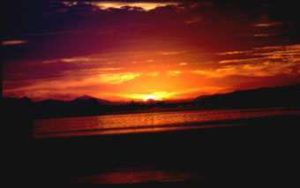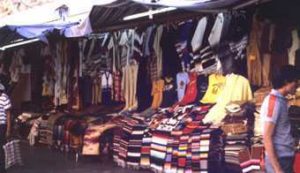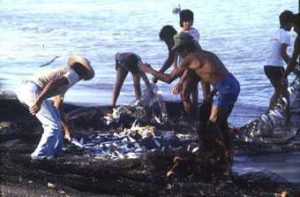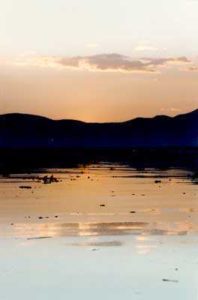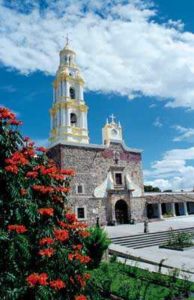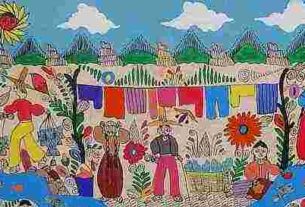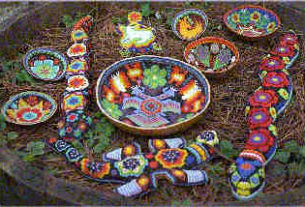Today Mary and I set out to drive completely around Lake Chapala, Mexico’s biggest lake. It’s quite an undertaking, about a 180-mile drive.
Before hitting the road, we went to “Sanborns” for breakfast. I ordered my own breakfast in Spanish, asking for eggs, ham, and orange juice. This was the second time I’d tried to order my own breakfast. I’d stumbled badly the first time, but this time I wasn’t even nervous. My Spanish is improving a little more every day. I can pick out quite a bit when listening to a Spanish conversation if it isn’t spoken too fast. It’s really neat to hear a conversation and to realize that people are just talking about everyday things, instead of hearing these mysterious random sounds being exchanged back and forth.
We took the periferico around town until we got to highway 23, which leads to the town of Chapala. As we buzzed down the road, I thought about my latest scheme to outwit the traffic cops. Whenever a cop stops you, they always ask for your driver’s license. If you hand it over to them, you are screwed. They will not give it back until you give them some money (they unscrew your license plates if you park illegally).
My plan is to copy my driver’s license with the scanner on my computer. I’m going to print out several full color copies and laminate them in plastic. Then I will cheerfully hand out copies to the police. I highly doubt they will know the difference. When they refuse to give me back my “license”, I’ll even more cheerfully tell them to keep it. I have this fantasy where a cop asks for my license, and I ask him, “How many do you want?” But that would be just a little too obvious, so I’ll just give them only one of my custom made “licenses”.
As we headed south toward Chapala, we noticed two dead burros along the road their bellies hugely swollen by internal gasses, their legs sticking straight out. They’d more than likely been hit at night. But what the heck, we’ve seen deer back in the US in the same condition.
More amazing than the burros was the fact that pedestrians were using an overhead walkway to cross the road. Usually Mexicans ignore these and jaywalk across a highway anywhere they want. The reason they were so law abiding quickly became apparent. There was an eight-foot high fence running down the median. Actually, I was surprised that someone hadn’t cut through it yet.
We passed several by-the-hour motels as we drew near the exit to the airport. It’s easy to spot this exit because there must be at least fifty billboards there strategically placed so that you can’t help seeing them as you drive from the airport into Guadalajara.
As we passed a truck, Mary said, “Lower sales”, and started laughing. A day or two previously I had read the slogan on a truck that read, “Baja En Sales.” I knew “baja” was Spanish for “low”, so I asked Mary, “Why would a company brag that it was low in sales?” She pointed out that “sales” was the plural of the Spanish word “sal”, which means, “salt”, and then burst out laughing. Their slogan was that their product was “low in salts”. Ha, ha. Very funny. It’s nice to know that I am so amusing.
One of Mary’s favorite expressions is, “We have people!” What she means by this is that we have a maid, a gardener, a boy who washes our car, a banker that thinks the world of Mary because she is so widely traveled, and we have a laundromat do our laundry. For some reason it tickles her that we have servants, albeit on a part-time basis. I guess she likes it so much because we could never afford this level of service back in the US.
Just before reaching Chapala we took the side road to the town of Ajijic (pronounced ah-hee-heek). Mary bought a rug from a roadside vendor for two hundred pesos. The asking price was four hundred pesos, but Mary was undecided on if she really wanted the rug, so the price dropped like a rock as the vendor realized that Mary was quite prepared to do without it.
Besides, Ajijic is loaded with foreigners, and four hundred pesos was an inflated tourist price. It really pays to speak Spanish as fluently as Mary does.
We had forgotten to take a camera along, so Mary ducked into a grocery store in Ajijic to buy a disposable one. She came back to the car with a camera and a box of baking soda, talking about all the US food products that were on sale in the store more even than the big Gigante supermarket or Costco back in Guadalajara has.
We drove down the road toward Jocotepec. It’s a nice road with some really beautiful houses along it (we had looked at one house in Ajijic on a previous trip where the asking price was over two hundred thousand dollars not pesos, dollars!). We passed a gate that had a sign, which read, “ Villa Nova”. Translation: “House of no go” – probably the home of a US or Canadian retiree.
We passed a dog eating a dead burro. I wanted to take a picture, but Mary wouldn’t let me. It’s just as well, though. The burro had been dead a long time.
We reached Jocotepec and promptly got lost. It wasn’t so much our own fault this time, though. There was an old banner stretched across the street that indicated that we should turn left to get to the next town on our route. Dutifully we turned left. We should have known better than to leave a paved street for a cobblestone one. We should also have remembered that many signs in Mexico indicate a turn long before where the turn actually is. In the US, one sees a sign that shows a turn ahead, followed by a sign where the turn actually is. Mexico uses two signs too. The only problem is that both signs are identical, and both indicate an immediate turn.
Somehow or other we managed to get on a street that led us out of the town. We were pleasantly surprised to find that we were on the right road.
We followed the road through the town of San Luis Soyatlan. The buildings on both sides of the road were right up to the highway. There was a sidewalk, but there was no room to park a car. Consequently, people parked their cars and trucks in the road while they went shopping. Not only that, but they parked them on which ever side the store was on, which meant that half the cars were parked facing the wrong way. Traffic had to snake through this mess as best as it could.
Further along the highway we spotted vultures circling something a ways off the highway. A few hundred feet further along, we spotted a few more vultures circling something in a pasture. I got out of the car to take a picture. There were scores of vultures on the ground. Mixed in with them were scores more of some white birds, perhaps from nearby Lake Chapala. I had no idea what breed of birds these were or what they were doing mixed in with vultures, but I snapped a quick picture and got back in the car before one of the cars whizzing past hit me. The road was narrow and had no shoulder. Some drivers were driving way too fast, and I could easily see how an animal might get hit and drag itself off the road to die in the bushes.
Mary’s back teeth were floating, so a Pemex station right outside a town was a welcome sight. As Mary went to make use of the facilities, an old man approached me with a basket of snacks he was selling. He had a small bag of dried green seeds that looked interesting, so I bought them for five pesos. Mary came back and we opened the bag. What it actually contained was dried peas. They were flavored with salt, chile peppers, and limon. They were quite tasty. Someone should definitely introduce this snack into the US, either by importing them or manufacturing the snack in the US.
We pulled out of the gas station onto the highway behind a pickup truck. Since we were immediately in town, the speed limit was low. That was a good thing because the truck driver ahead of us was so drunk that he could hardly stay on his side of the road at only fifteen miles an hour. He drifted across the centerline and then off the edge of the road, hitting a pothole that violently shook the truck. It must have wakened him up a little because he thankfully managed to negotiate a left turn onto a side street.
For some reason I started thinking about an amnesty program that the government had just announced. Mexico tries to protect its auto industry by forbidding the importation of cars from the US. But it seems that millions of Mexicans can’t resist the comparatively low car prices in the US even though the government immediately confiscates any illegal cars it gets its fingers on. The government declared an amnesty despite the vociferous objection of the auto industry and car dealers nationwide. I was idly wondering why the government was being so nice when it hit me. All those registration and license plate fees would bring a sizeable pile of pesos into the government coffers. The car dealers and the auto industry? Screw them! Ah politicians, why can’t they be an endangered species?
One thing Mary and I were glad to see was that there were bushes in the water where they normally can’t grow. It looked like the water had recently risen which is very good news for Lake Chapala since Guadalajara has almost drained it dry.
We came upon small village that was perched on a small hill near the highway. The hill looked like it used to be an island back when the water level was higher. A twisty paved road beckoned us off the highway toward the town, so we followed it into the village of Petatan.
One of the first things we saw in the village was a girl on a foot scooter trailing behind a boy on a bicycle. They had tied a rope between the two of them so that the boy could pull the girl. I thought it was quite ingenious. By the way, scooters were THE Christmas gift this past year in Mexico.
The streets, if you could call them that, were quite steep and in poor condition. After a block or two we decided to try to abandon our attempt to explore the town. We took a right turn over a huge tope (speed bump) to try to circle the block and came upon a crowd of kids near a small store. Surrounding the kids and the store was a big cloud of flies that immediately poured into the car. As we navigated our way through the kids, brushing at the flies, one of the kids said, “What’s your name?” through the open window. We were surprised at this level of education and would have stopped to talk, but the flies were relentless.
We managed to circle the block and head back out of town. Mary and I both marveled at the beautiful flowers growing right next to the heaps of garbage along the road.
Further down the highway, as we neared the town of La Barca, we entered a swampy region where we waited our turn to cross a one lane bridge. At La Barca we caught highway 35 which would lead us back west over the top of Lake Chapala.
Highway 35 is nominally a two-lane road. At least that’s how the traffic lines are painted on the road. But the two lanes are wide and the road even has a shoulder, so Mexicans being Mexicans have turned it into something between a three and a four-lane road. What you do is consider the shoulder as a traffic lane. But the regular lane plus the shoulder aren’t quite wide enough for two cars to drive side by side. The inner car slops over into the oncoming traffic a little. Well that’s ok, you pass slower cars (which voluntarily hug the right side of the road) just do it when there isn’t somebody coming at you from the other direction. Meanwhile opposing traffic is following the same strategy. So what you wind up with is a four-lane highway where the two center lanes of opposing traffic overlap.
Driving this road demands nerves of steel. You eyeball the traffic, trying to guess if the oncoming semi-truck passing another truck will complete his maneuver soon enough so that he can pull back into his outer lane and allow you to pass the truck in front and to the right of you. If you guess wrong, it’s a head-on collision. Mary’s nerves couldn’t take it after a while, so I had to ease back on my driving. I wonder what the death rate is on that highway?
I told Mary that the map showed a dirt road that we could take as an alternate route. I told her that it even had a three goat rating, but she was not amused.
We hit highway 23 and followed it back to Guadalajara. We stopped at a McDonalds near home and bought three quarter pound hamburgers and a large order of french fries. The bill was eighty pesos, which comes out to around eight dollars at the current rate of exchange. This is in a country were most people earn the equivalent of eleven dollars a day. No way can the average Mexican afford to eat there. I know that you can buy a meal at a Mexican “Kentucky Fried Chicken” for half as much as it costs in the US.
So why does food cost as much at a McDonalds in Mexico as it does in the US? Can you say “GREED”? I don’t think I will ever eat at a McDonalds again.

